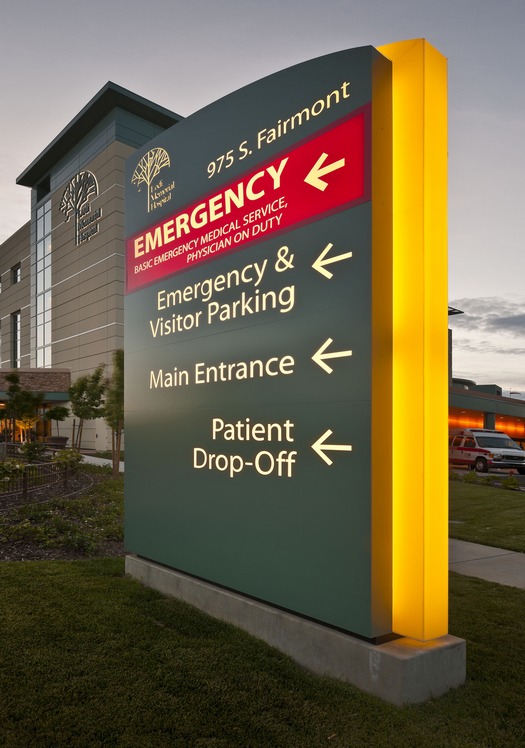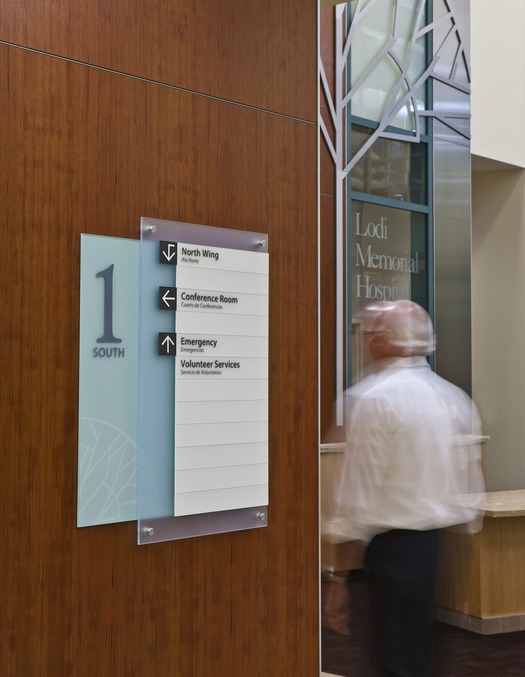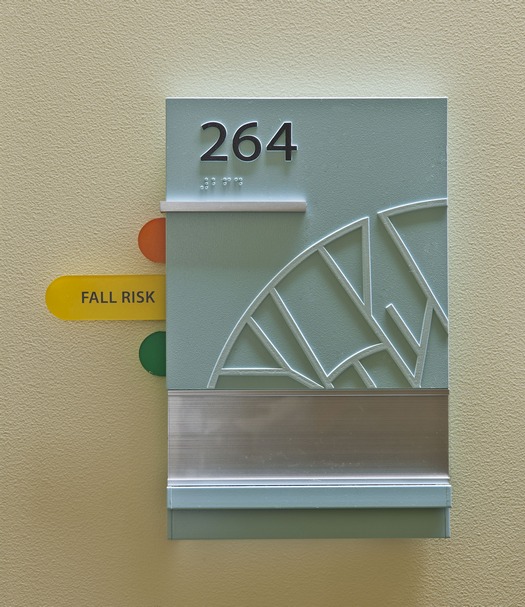Subscribe Now
Sustainability and Signage: The Points Add Up
By Jeff Zoll
 Thinking green. Building green. Buying green. The fact that “green” and in healthcare projects, LEED, has become part of our collective consciousness is a good thing. Companies and institutions not only enjoy social, environmental and financial benefits from eco-friendly activities; they also generate goodwill within the communities they serve.
Thinking green. Building green. Buying green. The fact that “green” and in healthcare projects, LEED, has become part of our collective consciousness is a good thing. Companies and institutions not only enjoy social, environmental and financial benefits from eco-friendly activities; they also generate goodwill within the communities they serve.
Currently, no LEED points are available specifically for signage, yet signage can still contribute to a project’s LEED Certification. Here’s how signage and green design can intersect.
The first two LEED categories, Sustainable Sites and Water Efficiency, do not have a direct relation to signage. However, signage can contribute to earning points in the Energy & Atmosphere category. This area focuses on energy efficiency, as explained on the USGBC website: “The Energy & Atmosphere category encourages a wide variety of energy-wise strategies: commissioning; energy use monitoring; efficient design and construction; efficient appliances, systems and lighting; the use of renewable and clean sources of energy, generated onsite or offsite and other innovative measures.”
The signage/wayfinding industry has already responded to the need for improving energy efficiency with increased use of Light Emitting Diodes for internally illuminated signs. LEDs use less power than fluorescent or neon light sources. LEDs last longer than fluorescent bulbs and therefore require less maintenance. And LEDs require a shallower cabinet than neon, which saves materials.
 Timers, dimmers, and photocells reduce electricity consumption by lighting signs only when necessary. Often, signage lighting can be tied in to the site-lighting controls, so that signage is lit only when a building’s exterior lighting is turned on. Additionally, use of solar power for exterior signage is an emerging trend in those geographic regions where this source makes sense.
Timers, dimmers, and photocells reduce electricity consumption by lighting signs only when necessary. Often, signage lighting can be tied in to the site-lighting controls, so that signage is lit only when a building’s exterior lighting is turned on. Additionally, use of solar power for exterior signage is an emerging trend in those geographic regions where this source makes sense.
Signage can also contribute to earning points in the Materials & Resources category. This category encourages the selection of sustainably grown, harvested, produced and transported products and materials. It promotes waste reduction as well as reuse and recycling, and it particularly rewards the reduction of waste at a product’s source.
Let’s face it: signage (like most other fabricated items and structures) is all about materials. This category focuses on the use of recycled and renewable materials in construction. Reducing wasted material and recycling of appropriate materials is also important within this category. There are hundreds of signage products on the market that tout greenness; I will focus on a few of them.
Aluminum is one of the most commonly used materials in sign construction, both interior and exterior. Aluminum extrusions with recycled content are readily available, and the use of recycled aluminum is prevalent in rolled aluminum products. A survey conducted by the Aluminum Association in mid-2008 indicated the total recycled content of domestically produced, flat-rolled products for the building and construction market was approximately 85 percent. Acrylic sheet used for lenses, letter faces, and other elements is also available with recycled content. Use of Forest Stewardship Council-certified wood should also be considered in signage using wood.
 In the last category, Indoor Environmental Quality, signage can also contribute to earning points. This category focuses on reducing harmful toxins in indoor air. The Indoor Environmental Quality category promotes strategies that improve indoor air as well as those that provide access to natural daylight and views and improve acoustics.
In the last category, Indoor Environmental Quality, signage can also contribute to earning points. This category focuses on reducing harmful toxins in indoor air. The Indoor Environmental Quality category promotes strategies that improve indoor air as well as those that provide access to natural daylight and views and improve acoustics.
Materials, paints and adhesives used for interior signage should have low VOCs to reduce the harmful effects of inhaling chemicals. Obviously, this benefits the building’s occupants as well as the people constructing the signs.
If signage is part of your green project, it can contribute to the LEED process. Although signage comprises a small part of the energy, material and environmental aspects of building design and construction, its thoughtful design can still contribute to earning an extra point here and there. Ultimately, a single point may make the difference between a building earning Gold or Platinum certification.
Jeff Zoll, LEED AP, EDAC, is a senior environmental graphic designer at HDR Architecture with 19 years of experience, focusing on healthcare and science and technology sectors. He has spent the past 14 years working with architects, interior designers, and site planners on large-scale signage and wayfinding projects. He is particularly interested in how human behavior relates to effective signage and how signage affects the environment
Photos of Lodi Memorial Hospital in Lodi, Calif. courtesy of HDR Architecture, Inc.; © 2010 Vance Fox
Editor’s Note: Stay tuned for our September/October issue, with a spotlight on signage/wayfinding.
Tags:
Posted July 13, 2011
More Articles:
- CxA Workshop & Exam
Apr 29, 2024 – Apr 30, 2024 - EMP Seminar & Exam at CxEnergy 2024
Apr 29, 2024 – Apr 30, 2024 - CxEnergy
Apr 29, 2024 – May 2, 2024 - PHCC West 2024
Apr 29, 2024 – May 2, 2024 - Lean in Design Forum 2024
May 1, 2024 – May 2, 2024 - IFMA’s Facility Fusion Conference & Expo
May 5, 2024 – May 7, 2024 - ASHE Academy 2024
May 6, 2024 – May 10, 2024










